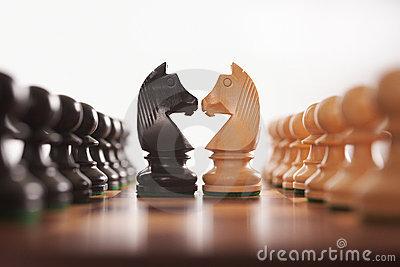
Opening, Middlegame, Endgame
3 Parts of a chessgame - Opening,endgame, middlegame
Hello Chessfriends, many players rated around 800-1500 ask themself how they can improve their chess to get to the next level. But most of them forget to stand to the basic rules, for example how a chessgame is constructed. A game of chess can be divided into 3 phases, the opening, the middlegame and the endgame. Each of this phases has his own rules and its important to stick to them. In this short blog I will try to show you the important prinicples of each phase of the game. I hope it will help all players who frequently forget about them. I will start with the opening.
The Opening:
- There are 2 important factors you have to consider: Development and Space/Center
-Always try to balance pros and cons between those 2 factors and try to get as much space and as much development in the opening as possible. On one side you need space to have enough squares to place your pieces on good squares but on the other side you need your pieces to be involved in the fight early to attack the opponents king and to bring your own king into safety. So the balance between Space and Development is extremly important.
- Try to place your pieces on the most active squares and place them so that they have a direct bearing on the center.
-The main goal of the opening is to be ready for the coming middlegame.
A simple example for a quick and logical opening phase is a line in the slow Italian Game:
The Middlegame:
- The middlegame begins when the development has finished and when all or at least most pieces are inbuilt in the game
-In the middlegame both sides should generate a plan whilst taking into account
1. Time: How long will it take to implement my plan?
2. Efficiency: Will I have a conspicuous benefit by the use of my plan?
3.Counterattacks in favor of the opponent: Has my opponent a chance to start a counterattack which might be possibly faster than my own plan/attack ?
-The realization of the plan takes place whilst taking into account
1: Weaknesses(of my opponent or of myself): Has my opponent any usable weaknesses, how exactly can I make use of them? Or have I myself weaknesses that I should better stamp out?
2: Tactical resources: Can I resort to some tactical resources to implement or to confirm my plan in a tactical way?
3: Logical candidate moves: Which logical moves are shortlisted to realize my plan? Which of these possible candidate moves is the best?
4: The best replies of the opponent(!): Always assume the best moves of your opponent and never calculate with the moves that would win for you. Chess is NOT Hope-Chess!
Here is a very typical and easy example for the plan finding:
The Endgame:
- Always try to find ways to process into a for you beneficial endgame. Never exchange pieces and never process into a endgame when this is obviously worse or even lost for you!
-In the endgame you need concrete knowledge. But even more important then this knowledge is the ability to calculate very precise lines. Exspecially in rook and pawn endgames every move can lead to an instant loss for you, even when you were completly winning one move earlier.
Conclusion:
1.Opening: get as much space and fast development as possible, place your pieces on actives and usefull squares
2.Middlegame:Develop a decent plan , use your all of your pieces and follow the mentioned rules
3.Endgame: The last phase of the game, calculate correct lines and use your endgame knowledge, look out to process into winning endgames but never process into losing ones
Here is an example where white was able to process into a winning endgame after blacks mistake Nf6:
I hope I could help everybody here with this very important basics of the chessgame. Only when you master the basic rules you can try to use advanced knowledge.
Cheers and please give me your feedback,
Till :)